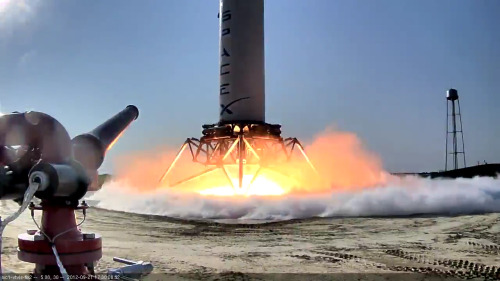I'm not sure if the SuperDraco engines provide enough thrust for landing on the Moon
They don't. Depending on the fuel loads, their delta-vee is around 400m/s: just enough to escape from an exploding rocket, or enough to slow to a stop from a terminal velocity of around 250m/s and then hover for a second or two just before touchdown. That, combined with Dragon's RCS thrusters, would give you about 700m/s, about a third of what you'd need for lunar deorbit and controlled landing (The Apollo LEM needed just under 2100m/s on its way down and the ascent stage needed 1500 on its way up).
I think we're saying "thrust" where we mean either impulse or delta-V. Since the SuperDracos are abort engines, they have enough thrust to accelerate the Dragon capsule away from an accelerating Falcon. The DragonRider has 8 SuperDracos, each with about 15,000 lbs thrust, but they are mounted at an angle so cosine losses drop the total to about 100,000 lbs, which on a 20,000 lb Dragon in launch configuration should give you about 5 G's acceleration. But there's not much fuel on board, so the mass ratio is very poor, as is the total delta-V.
First of all, I knew exactly what you were saying.
I am saying that the Delta-v for the Superdracos in an abort configuration is a little over 400m/s. It could be considerably less for a controlled landing because terminal velocity near sea level is going to be quite a bit less than that, but for a range of plausible ISPs plus how much fuel they've got on board (not to mention what an abort thruster would have to be able to produce in order to be useful in that role) it's no less than 400 and no more than 600.
Second of all, when you start running the rocket equation to figure these things out, the only thing that really matters is the amount of propellant on board the craft. Even an increase or decrease in ISP doesn't make a huge difference unless you double or triple it. The cosine losses don't count for much; the only way to get a lot of movement for the SuperDracos in terms of performance is to change the fuel they're using and increase the combustion chamber pressure, and once you've done that, you've basically developed a whole new engine.
The engines would probably have an ISP of around 300
They
wish. 270 is probably pushing it, 210 is more realistic considering the superdracos won't have comparatively large nozzles.
Since the fuel-fraction is so low, I'll skip the rocket equation
I
didn't skip the rocket equation, I spent a couple of days last year going through these calculations.
The Apollo Descent Engine only had a tenth as much thrust as the Dragon abort engines
But the descent MODULE had ten times the fuel capacity and a slightly higher ISP, thus a larger overall delta-v. Significantly: even if you used the DragonRider with half of its superdracos firing and throttled way down to about 1.6m/s^2 (enough to hover over the surface of the moon) they would only be able produce that low acceleration for a finite period of time (250 seconds, with a D-V of 400m/s).
The thing is, the Dragon is coming to a landing on the lunar surface from orbital velocity of about 1600m/s. That means that even if all eight of those superdracos fire at maximum thrust and burn until they're bone dry, Dragon will still be moving way too fast to land safely. Even more importantly, if you somehow added enough fuel to cancel its orbital velocity entirely, you still need another minute or so of hover time to give your pilots time to zero in on a landing site, and another 1000 or more in reserve if you have to abort your landing and jump back into orbit.
The change they sould make is eliminating the cosine losses (which directly reduce the ISP) by realigning the engines or using a seperate vertical SuperDraco for ascent and descent.
That would change nothing, since even a 70% increase in ISP -- way more than you'd get from the cosine losses -- would still leave the Dragon about 1000m/s short of a safe landing.
What they actually need is about 7 times more propellant than the Dragon can carry internally; the lunar descent stage carried 8 tons of hypergolic propellants to the Dragon's 1200km and the Dragonrider's (probable) 2000kg. So Dragon either needs to add some gigantic propellant tanks under its heat shield (like the Soviet lunar landers; their ascent/descent engine was on the capsule and the landing stage was just fuel and legs) or it needs to get about 90% lighter.






